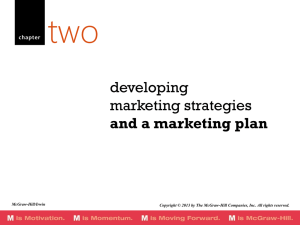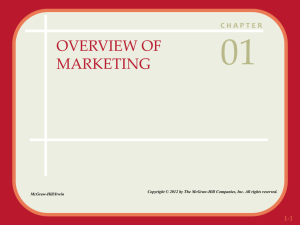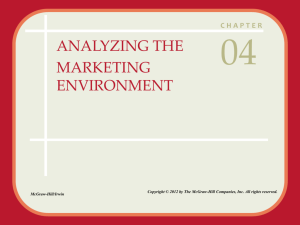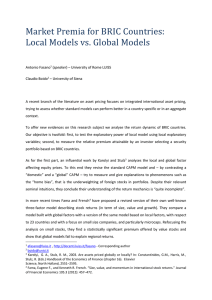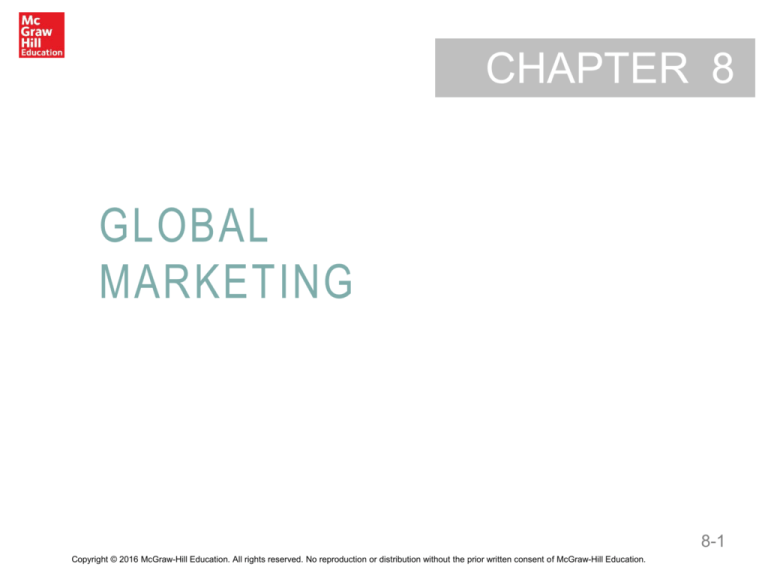
CHAPTER 8
GLOBAL
MARKETING
8-1
Copyright © 2016 McGraw-Hill Education. All rights reserved. No reproduction or distribution without the prior written consent of McGraw-Hill Education.
Global Marketing
LEARNING OBJECTIVES
LO1
Describe the components of a country market
assessment.
LO2
Understand the marketing opportunities in BRIC
countries.
LO3
Identify the various market entry strategies.
LO4
Highlight the similarities and differences between
a domestic marketing strategy and a global
marketing strategy.
8-2
Coca-Cola
Erica Simone Leeds RF
8-3
STR/AFP/Getty Images
Growth of Global Market
8-4
Hiring Overseas
8-5
Assessing Global Markets
General economic
environment
Market size and
population growth
Real income
Power distance
Uncertainty avoidance
Individualism
Masculinity
Time orientation
Transportation
Channels
Communication
Commerce
Economic
analysis using
metrics
Infrastructure
and technology
Sociocultural
analysis
Government
actions
Tariff
Quota
Exchange control
Trade agreement
8-6
Economic Analysis
General Economic Environment
Gross
domestic
product
Gross national
income
Purchasing
power parity
Human
development
index
NationMaster
8-7
Evaluating Market Size
and Population Growth Rate
Population 2002
Population 2050
REUTERS/Arko Datta/Corbis.
8-8
REUTERS/Fayza Kabli
Firms can make
adjustments to an
existing product or
change the price to
meet the unique
needs of a particular
country market.
Narinder Nanu/AFP/Getty Images
Evaluating Real Income
8-9
Stockdisc
©MIXA/PunchStock
Analyzing Infrastructure
and Technological Capabilities
Transportation
Royalty-Free/CORBIS
PhotoLink/Getty Images
Communication
Distribution Channel
Commerce
8-10
Analyzing Government Actions
Tariff
Trade
agreement
Government
actions
Quota
Exchange
control
8-11
Tariff and Quotas
Tariffs
• Tax
• Artificially raises
prices
• Lowers demand
Quotas
• Maximum limit
• Reduces
availability of
imported goods
Both benefit domestically made products
because they reduce foreign competition
8-12
Exchange Control
Image Source/Alamy
Exchange rate
Stockbyte/Punchstock Images
Countertrade
8-13
Trade Agreements
8-14
The European Union (EU)
Monetary and Trade
Union
Euro
Membership does not
consists of Croatia,
Macedonia, Turkey
and several others
8-15
Analyzing Sociocultural Factors
Individualism
Masculinity
Uncertainty
avoidance
Power
distance
Time
orientation
Culture
Indulgence
8-16
Country Clusters
8-17
Country Clusters
Using the Geert
Hofstede’s cultural
dimensions concept,
what type of cultural
difference is affecting
the person in the
picture?
McGraw-Hill Companies, Inc. Mark Dierker, photographer.
Uncertainty
Avoidance
8-18
The Appeal of the BRIC Countries
Great potential for
growth in the global
community
Brazil
Russia
India
China
8-19
CHECK YOURSELF
1. What are key metrics that can help analyze the
economic environment of a country?
2. What types of government actions should we
be concerned about as we evaluate a country?
3. What are five important cultural dimensions?
4. Why are each of the BRIC countries viewed as
potential candidates for global expansion?
8-20
Choosing a Global Entry Strategy
Direct
Investment
Control
Joint
Venture
Strategic
Alliance
Franchising
Export
Risk
8-21
CHECK YOURSELF
1. Which global entry strategy has the least risk
and why?
2. Which global entry strategy has the most risk
and why?
8-22
Choosing a Global Marketing Strategy:
Target Market (STP)
Cultural nuances
Subcultures
View of product and consumer role
Different positioning
Adaptation
Courtesy Ford India Pvt. Ltd.
Single positioning strategy
8-23
The Global Marketing Mix:
Product or Service Strategies
Sell the same
product or service
in both the home
country market and
host country
Sell a product or
service similar to
that sold in home
country but include
minor adaptations
Sell totally new
products or
services
8-24
Global Marketing Mix:
Pricing Strategies
Anti-dumping
Policies
Economic
Conditions
Quotas
Tariffs
Price
Competitive
factors
8-25
Global Marketing Mix:
Global Distribution Strategies
Some global channels
are very long and
complex.
Consumer shop local
small local stores.
Suppliers must be
creative in delivering
to these outlets.
http://www.youtube.com/watch?v=MrMURochE6Y
8-26
Global Marketing Mix: Global
Communication Strategies
Literacy levels vary by
country
Firms choose whether to
adapt to language
differences
Cultural and religious
differences also matter
Photo by Jeff Kravitz/FilmMagic/Getty Images
8-27
Spanish Ad
Courtesy Nestlé SA
8-28
CHECK YOURSELF
1. What are the components of a global marketing
strategy?
2. What are the three global product strategies?
8-29


